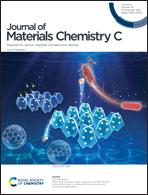Sky-blue delayed fluorescence molecules based on pyridine-substituted acridone for efficient organic light-emitting diodes†
Abstract
In comparison with green and red OLEDs, which have been well developed with satisfactory electroluminescence (EL) performances, high-efficiency blue OLEDs still need further exploration. Herein, by reasonably strengthening the rigidity of molecules, three new sky-blue thermally activated delayed fluorescence molecules based on electron-withdrawing acridone and electron-donating acridine derivatives are designed and synthesized. Their crystal and electronic structures, thermal stabilities, electrochemical behaviors and photophysical properties are systemically investigated. The results show that these molecules have high thermal and electrochemical stabilities and exhibit aggregation-induced emission and eminent sky-blue delayed fluorescence with emission peaks at 480–502 nm and high fluorescence quantum yields of 78–94% in doped films. Their OLEDs exhibit sky-blue EL emissions with peaks at 482–492 nm, and achieve excellent external quantum efficiencies of 21.8–26.8%. These results indicate that the new sky-blue delayed fluorescence molecules hold good potential as light-emitting materials for OLEDs.



 Please wait while we load your content...
Please wait while we load your content...